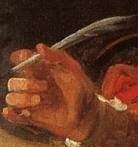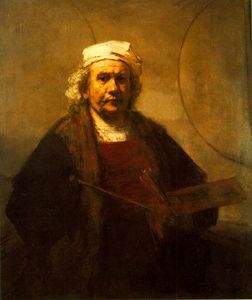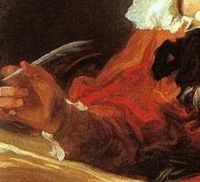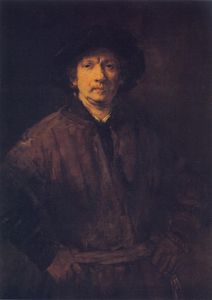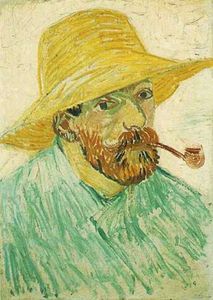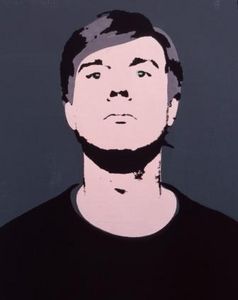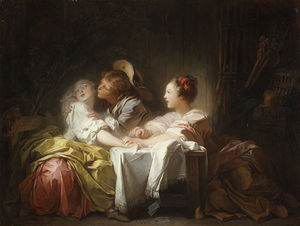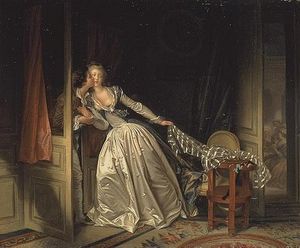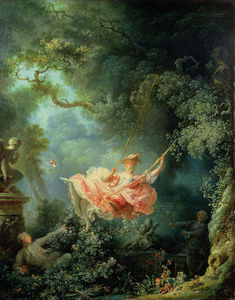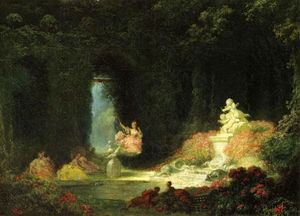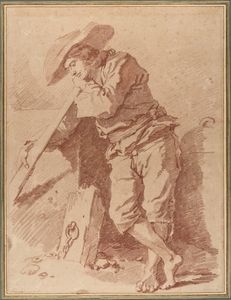Inspiration
- Date of Creation:
- 1769
- Alternative Names:
- Inspiration (Self Portrait)
- Height (cm):
- 80.00
- Length (cm):
- 64.00
- Medium:
- Oil
- Support:
- Canvas
- Subject:
- Figure
- Art Movement:
- Rococo
- Created by:
- Current Location:
- Paris, France
- Displayed at:
- Musée du Louvre
- Owner:
- Musée du Louvre
- Inspiration Page's Content
- Story / Theme
- Analysis
- Related Paintings
- Artist
- Art Period
- Bibliography
Inspiration Story / Theme
Inspiration (Self Portrait) is so different from many of Fragonard's other paintings in that it is more warm, wistful, and frothy than his other portraits and was produced during the artist's early years.
Fragonard's intent here is not only to represent himself on canvas, but also to depict the moment when an artist receives inspiration from a subject. By leaving the subject unknown, the painting becomes a source of inspiration itself, in either a common or divine sense.
The artist is caught mid-pose, his actions frozen, his hand with brush in tow, ready for the next action that he will draw from this unseen inspiration.
Fragonard wasn't the first artist that decided it would be a good idea to portray himself in the act of painting. Dutch masters such as Rembrandt had long been profound stylistic influences on the Frenchman.
Rembrandt completed a vast number of self portraits and they display the same dramatic lighting and attention to detail that would inform the treatment of his expression, coloring, and careful brushwork.
Inspiration Analysis
Composition:
The artist poses in a pleasing triangular shape, taking up the bulk of the space. The viewer's eye is drawn in a perfect triangle from the artist's face, lit up with inspiration, down his shoulder to the hand resting in the southeast corner of the canvas, and then along his drafting table to the hand holding the brush. There is a natural fluidity to the viewer's gaze.
The artist wears plush, warm and natural yet frilly clothing. Typical of Fragonard's work, there is great attention to detail in rendering this garb, to suit the dandyish Rococo tastes.
Color Palette:
Inspiration, in popular Rococo style, is painted in soft yet warm colors. The artist's face is ruddy, almost as if he is wearing rouge. His flesh is pink, red, rosy, and looks warm to the touch.
Fragonard's clothing accentuates this feeling of warmth. He uses rose, orange, and tones of pastel subdued clay, burnt sienna, cream, and a soft grey for his own hair.
Use of light:
Fragonard utilizes chiaroscuro and a stark contrast between the light that illuminates the artist (as if the light itself is the divine inspiration) and the darkness of the shadows that lie behind him. This gives a subtle emphasis to the artist's facial expression and movement.
Tone elicited:
Primarily through the use of color and lighting, the mood of this painting is one of contemplation, elegance, and respect for the traditions of artistic inspiration.
Brushstrokes:
Fragonard employs the fluid, swift, broad brushstrokes that were his bread and butter during this time period. This adds movement to the composition, as well as a light touch to the portrait.
Inspiration Related Paintings
Inspiration Artist
A reflection on artistic creation and a somewhat egotistical ode to himself, Inspiration is a typical Fragonard portrait: sumptuous, a bit over-the-top, and lighthearted. The subdued nature of this portrait compared to his other works, however, allowed Inspiration to survive the years of criticism better than his other works, such as The Swing.
As charming and witty as his paintings, Jean-Honoré Fragonard was one of the most prolific artists of his time, producing more than 550 works during his career.
Serving as an apprentice to Chardin and Boucher, two of the premier Rococo artists he later won the Prix de Rome and attended the French Academy. Fragonard's work came with a high pedigree and prestige and as one of the last artists of the Rococo; his name is almost synonymous with this frivolous, erotic, and decadent movement.
Reputedly one of the most prolific painters of the 18th century, if not of all time, Fragonard had a feverish output of varied subject matter. From portraits to scenes of pastoral, erotic, or domestic appeal he covered a wide range of themes.
Fragonard's work is easily recognizable due to the lightness and frivolity of the subject matter, the deft touch of the brushwork, and the soft, carefree lighting schemes.
Today Fragonard is thought of as a relic of a time past, a testament to a somewhat innocent time period before the French Revolution wiped out the aristocracy and ushered in a new era of democracy.
The Rococo has not weathered the test of time too well as far as being heralded as an artistic period that produced anything of importance. Rococo artists lived in their own bubble, much like the noble class of the day, and now their work is regarded more out of historical interest rather than artistic.
Inspiration Art Period
Fragonard was a product of the later stages of the Rococo era, a time characterized by hedonistic freedom and a pursuit of all things aesthetically pleasing. The Rococo era originated from the French decorative style Racaille meaning 'decorative shell and rock work'.
Rococo was created by and for the rich of France. They wanted works that reinforced their wealth and pleasure in all beauty and splendor, as artists recreated scenes of arcadia. The Palace of Versailles was the ideal in decadent Rococo art and architecture, informed by ideas of the French Enlightenment.
A master of the domestic scene, the pastoral landscape and tongue-in-cheek eroticism of the boudoir painting, Fragonard had his share of admirers and wielded a strong influence over future masters of the art world, particularly the Impressionists.
Impressionism as a movement bears similarities to the Rococo in its emphasis on fleeting moments of beauty, sudden impressions, and pleasure.
Although for a time after the Revolution Fragonard disappeared from the history of art, his wittily airy style cropped up again years later with a new legion of imitators and by the end of the 19th century there was a rediscovery of Fragonard and other Rococo artists.
Inspiration Bibliography
For further information about Jean-Honoré Fragonard's contribution to the Rococo movement, please choose from the following recommended sources.
• Ashton, D. Fragonard in the Universe of Painting. Prentice Hall & IBD, 1988
• Cuzin, Jean-Pierre. Fragonard: Life and Work. Harry N. Abrams, Inc. , 1988
• Dupuy-Vachey, Marie-Anne. Fragonard. Pierre Terrail, 2006
• Molotiu, Andrei. Fragonard's Allegories of Love. J Paul Getty Trust Publications, 2008
• Massengale, Jean Montague. Fragonard (Masters of Art). Harry N. Abrams, Inc. , 1998
• Rosenberg, Pierre. Fragonard: Metropolitan Museum of Art. Harry N. Abrams, Inc. , 1988
• Rosenberg, Pierre. From Drawing to Painting: Poussin, Watteau, Fragonard, David, and Ingres (A. W. Mellon Lectures in the Fine Arts). Princeton University Press, 2000
• Sheriff, Mary D. Fragonard: Art and Eroticism. University of Chicago Press; 2nd edition, 1990


